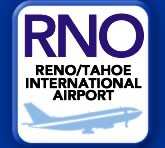FAA Manager Replies "We're So Safe, It's Ridiculous"
 Regular Aero-News readers are
quite familiar with the ongoing war of words between air traffic
controllers and the FAA, ever since the agency imposed a new
five-year contract following the breakdown in negotiations between
the two sides last year. For controllers who are planning to retire
this year from their jobs in the control tower at Reno-Tahoe
International Airport, though, what is seen by many as a political
battle is also a very personal one.
Regular Aero-News readers are
quite familiar with the ongoing war of words between air traffic
controllers and the FAA, ever since the agency imposed a new
five-year contract following the breakdown in negotiations between
the two sides last year. For controllers who are planning to retire
this year from their jobs in the control tower at Reno-Tahoe
International Airport, though, what is seen by many as a political
battle is also a very personal one.
"I love it," said Dave Berrang, telling the Reno Gazette-Journal
about his 23 years as an air traffic controller. "I bet you ask any
air traffic controller anywhere, who wouldn't say they love their
job."
Berrang is one of five controllers at RNO who have announced
they will retire this year; a sixth is eligible. That's a big
number, Berrang says... and he and others are worried about
safety.
"As an air traveler, I'd be concerned about the way the agency
is staffing facilities across the nation," he said. "It's becoming
unsafe."
That's an assertion -- echoed by air traffic controllers
throughout the country, as well as the National Air Traffic
Controllers Association -- that FAA Tower Manager Donald Brooks
flatly denies.
"Our staffing meets our need, and we are more than able to
safely provide ATC services," Brooks said. "We're so safe, it's
ridiculous."
Brooks does concede staffing levels at RNO are slightly lower
than they should be, however. Earlier this year, the FAA lowered
the number of authorized controllers required to be in Reno's Class
C tower to between 20 and 24 -- down from 27 three years ago. At
the moment, RNO has 16 certified controllers on staff, and another
six at varying stages in their training.
"We're slightly outside of range at the moment," Brooks admits.
"My guess is about in 2008, we will be completely good to go."
Representatives with airlines flying into Reno -- most notably
Southwest Airlines -- express confidence the FAA has a handle on
the situation, and the agency's ability to maintain safety.
"We know the issue has been on the front burner for several
years," Southwest spokeswoman Paula Berg told the paper. "We stay
plugged in and monitor the situation through ATA."
"We look to the FAA to assess those needs," adds Elizabeth
Merida, spokeswoman for the Air Transport Association. "The
industry safety records speak for themselves, and we trust the FAA
to continue to assess the proper staffing needs."
FAA spokesman Ian Gregor says the agency has a plan to handle
lower staffing levels -- by bringing new controllers online, and
consolidating positions. Reno is a good example of a facility that
can handle such a reduction, he adds, due to its reasonably light
traffic load -- on average, controllers talk with six airplanes at
a time.
"That is a very safe thing to do at a low-traffic facility such
as Reno," he said. "Also, it is a common measure at facilities all
over the country."
 Berrang disputes that
total, saying he and other controllers in the tower cab, and the
radar room downstairs at RNO, may talk to as many as 12 planes at
any one time.
Berrang disputes that
total, saying he and other controllers in the tower cab, and the
radar room downstairs at RNO, may talk to as many as 12 planes at
any one time.
"[W]e don't feel it's safe," he said. "I don't want to be flying
in skies that aren't safe because the agency isn't staffing
facilities to take care of the number of airplanes."
Controller John Lopez says a recent incident at RNO shows why
more eyes, not fewer, are needed in the tower. "A clearance
controller making corrections for an aircraft did not catch an
aircraft about to cross an active runway because their attention
was diverted to other responsibilities," he said. "The ground
position has to have eyes out the window."
Lopez also expressed doubts on the ability of certified
controllers to train new hires, while also working consolidated
positions.
"The problem is, who is going to train them?" he said. "I was
training four to five hours a day when I was a trainee. And some of
our trainees are lucky to get four to five hours a week."
 ANN's Daily Aero-Linx (04.15.24)
ANN's Daily Aero-Linx (04.15.24) Classic Aero-TV: 'No Other Options' -- The Israeli Air Force's Danny Shapira
Classic Aero-TV: 'No Other Options' -- The Israeli Air Force's Danny Shapira Aero-News: Quote of the Day (04.15.24)
Aero-News: Quote of the Day (04.15.24) Airborne 04.16.24: RV Update, Affordable Flying Expo, Diamond Lil
Airborne 04.16.24: RV Update, Affordable Flying Expo, Diamond Lil ANN's Daily Aero-Term (04.16.24): Chart Supplement US
ANN's Daily Aero-Term (04.16.24): Chart Supplement US




